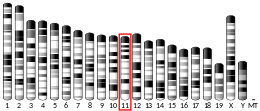
Back بروتين تاو Arabic MAPT BS Proteïna Tau Catalan Tau (protein) Czech MAPT Welsh Tau-protein Danish Tau-Protein German Πρωτεΐνη ταυ Greek Proteína tau Spanish پروتئین تاو Persian
The tau proteins (abbreviated from tubulin associated unit[5]) form a group of six highly soluble protein isoforms produced by alternative splicing from the gene MAPT (microtubule-associated protein tau).[6][7] They have roles primarily in maintaining the stability of microtubules in axons and are abundant in the neurons of the central nervous system (CNS), where the cerebral cortex has the highest abundance.[8] They are less common elsewhere but are also expressed at very low levels in CNS astrocytes and oligodendrocytes.[9]
Pathologies and dementias of the nervous system such as Alzheimer's disease and Parkinson's disease[10] are associated with tau proteins that have become hyperphosphorylated insoluble aggregates called neurofibrillary tangles. The tau proteins were identified in 1975 as heat-stable proteins essential for microtubule assembly,[5][11] and since then they have been characterized as intrinsically disordered proteins.[12]

- ^ a b c ENSG00000276155, ENSG00000277956 GRCh38: Ensembl release 89: ENSG00000186868, ENSG00000276155, ENSG00000277956 – Ensembl, May 2017
- ^ a b c GRCm38: Ensembl release 89: ENSMUSG00000018411 – Ensembl, May 2017
- ^ "Human PubMed Reference:". National Center for Biotechnology Information, U.S. National Library of Medicine.
- ^ "Mouse PubMed Reference:". National Center for Biotechnology Information, U.S. National Library of Medicine.
- ^ a b Weingarten MD, Lockwood AH, Hwo SY, Kirschner MW (May 1975). "A protein factor essential for microtubule assembly". Proceedings of the National Academy of Sciences of the United States of America. 72 (5): 1858–62. Bibcode:1975PNAS...72.1858W. doi:10.1073/pnas.72.5.1858. PMC 432646. PMID 1057175.
- ^ Goedert M, Wischik CM, Crowther RA, Walker JE, Klug A (June 1988). "Cloning and sequencing of the cDNA encoding a core protein of the paired helical filament of Alzheimer disease: identification as the microtubule-associated protein tau". Proceedings of the National Academy of Sciences of the United States of America. 85 (11): 4051–5. Bibcode:1988PNAS...85.4051G. doi:10.1073/pnas.85.11.4051. PMC 280359. PMID 3131773.
- ^ Goedert M, Spillantini MG, Jakes R, Rutherford D, Crowther RA (October 1989). "Multiple isoforms of human microtubule-associated protein tau: sequences and localization in neurofibrillary tangles of Alzheimer's disease". Neuron. 3 (4): 519–26. doi:10.1016/0896-6273(89)90210-9. PMID 2484340. S2CID 19627629.
- ^ Sjölin K, Kultima K, Larsson A, Freyhult E, Zjukovskaja C, Alkass K, et al. (June 2022). "Distribution of five clinically important neuroglial proteins in the human brain". Molecular Brain. 15 (1): 52. doi:10.1186/s13041-022-00935-6. PMC 9241296. PMID 35765081.
- ^ Shin RW, Iwaki T, Kitamoto T, Tateishi J (May 1991). "Hydrated autoclave pretreatment enhances tau immunoreactivity in formalin-fixed normal and Alzheimer's disease brain tissues". Laboratory Investigation; A Journal of Technical Methods and Pathology. 64 (5): 693–702. PMID 1903170.
- ^ Lei P, Ayton S, Finkelstein DI, Adlard PA, Masters CL, Bush AI (November 2010). "Tau protein: relevance to Parkinson's disease". The International Journal of Biochemistry & Cell Biology. 42 (11): 1775–8. doi:10.1016/j.biocel.2010.07.016. PMID 20678581.
- ^ Cleveland DW, Hwo SY, Kirschner MW (October 1977). "Purification of tau, a microtubule-associated protein that induces assembly of microtubules from purified tubulin". Journal of Molecular Biology. 116 (2): 207–25. doi:10.1016/0022-2836(77)90213-3. PMID 599557.
- ^ Cleveland DW, Hwo SY, Kirschner MW (October 1977). "Physical and chemical properties of purified tau factor and the role of tau in microtubule assembly". Journal of Molecular Biology. 116 (2): 227–47. doi:10.1016/0022-2836(77)90214-5. PMID 146092.






